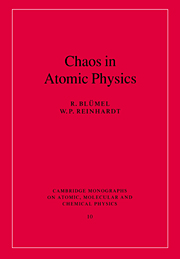Book contents
- Frontmatter
- Contents
- Preface
- 1 Introduction
- 2 Chaos: tools and concepts
- 3 Chaos in classical mechanics
- 4 Chaos in quantum mechanics
- 5 The kicked rotor: paradigm of chaos
- 6 Microwave-driven surface state electrons
- 7 The hydrogen atom in a strong microwave field
- 8 The kicked hydrogen atom
- 9 Chaotic scattering with CsI molecules
- 10 The helium atom
- 11 Chaos in atomic physics: state of the art and research directions
- References
- Index
Preface
Published online by Cambridge University Press: 14 September 2009
- Frontmatter
- Contents
- Preface
- 1 Introduction
- 2 Chaos: tools and concepts
- 3 Chaos in classical mechanics
- 4 Chaos in quantum mechanics
- 5 The kicked rotor: paradigm of chaos
- 6 Microwave-driven surface state electrons
- 7 The hydrogen atom in a strong microwave field
- 8 The kicked hydrogen atom
- 9 Chaotic scattering with CsI molecules
- 10 The helium atom
- 11 Chaos in atomic physics: state of the art and research directions
- References
- Index
Summary
Atomic physics is one of the oldest fields of physics. A barren and “academic” discipline? Not at all! About ten years ago, atomic physics received a rejuvenating jolt from chaos theory with far reaching implications. Chaos in atomic physics is today one of the most active and prolific areas in atomic physics. This book, addressed at interested students and practitioners alike, is a first attempt to provide a coherent introduction into this fascinating area of contemporary research. In line with its scope, the book is essentially divided into two parts. The first part of the book (Chapters 1 – 5) deals with the theory and philosophy of classical chaos. The ideas and concepts developed here are then applied to actual atomic and molecular physics systems in the second part of the book (Chapters 6 – 10).
When compiling the material for the first part of the book we profited immensely from a number of excellent tutorials on classical and quantum chaos. We mention the books by Lichtenberg and Lieberman (1983), Zaslavsky (1985), Schuster (1988), Sagdeev et al. (1988), Tabor (1989), Gutzwiller (1990), Haake (1991), Devaney (1992) and Reichl (1992).
The illustrative examples for the second part of the book were mostly taken from our own research work on the manifestations of chaos in atomic and molecular physics. We apologize at this point to all the numerous researchers whose work is not represented in this book. This has nothing to do with the quality of their work and is due only to the fact that we had to make a selection.
- Type
- Chapter
- Information
- Chaos in Atomic Physics , pp. xiii - xviPublisher: Cambridge University PressPrint publication year: 1997

